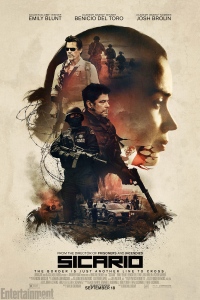 FBI Agent Kate Macer (Emily Blunt) is recruited by the CIA’s Matt Graver (Josh Brolin) to help infiltrate a Mexican drug cartel. She feels lost and out of bounds, outside of her comfort zone and jurisdiction, and she asks the DoD “consultant” Alejandro (Benicio Del Toro) what exactly is their objective. “You’re asking me how a watch works,” Alejandro implies, intricate and detailed yes, but more importantly difficult and near impossible to understand.
FBI Agent Kate Macer (Emily Blunt) is recruited by the CIA’s Matt Graver (Josh Brolin) to help infiltrate a Mexican drug cartel. She feels lost and out of bounds, outside of her comfort zone and jurisdiction, and she asks the DoD “consultant” Alejandro (Benicio Del Toro) what exactly is their objective. “You’re asking me how a watch works,” Alejandro implies, intricate and detailed yes, but more importantly difficult and near impossible to understand.
“Sicario” is a film about frustration. Like “Zero Dark Thirty” before it, Kate Macer is a woman trying to see in the dark and coming up empty. Denis Villeneuve’s tightly wound thriller binds its main character in confusion, ambiguity and a lack of information. The audience finds only a little more clarity but can feel the slow-burn tension sink in as Kate continues to go deeper, unsure of what she’ll find.
Kate’s most recent raid uncovered a house filled with bodies lining the inside of the drywall, each bound and wrapped in a plastic bag around their head. Despite the gruesome failure of the operation, she’s whisked away by the CIA’s Matt Graver, his flip flops and casual demeanor in stark contrast to her worn and by-the-book dedication to her job.
Matt’s details are scant, and instead of taking her to El Paso, she’s brought along on a job in Mexico. She’s part of a massive convoy that rolls into the country to pick up a cartel prisoner, then crosses back over the border to interrogate him. Villeneuve makes us helpless passengers and reluctant spectators, with the convoy calling complete attention to itself and with sinister looking gang bangers itching their trigger fingers in between rows of civilian traffic at the Mexican-American border. The musical score in this scene has a wonderful low droning of horns and the dragging of chains or stones as a chopper flies by.
The intention of this and several of the film’s operations are never completely clear, but in Benicio Del Toro we get a brilliant character who stands apart from the other agents and strikes fear into everyone on screen. Villeneuve and screenwriter Taylor Sheridan carefully tap into the idea that Kate and everyone else involved are really playing toward his agenda. His ruthless, yet incredibly subdued performance is one of the finer supporting jobs of the year.
This fear of uncertainty of an agenda and of a direction manifests itself brilliantly in a night-vision sequence that recalls and perhaps surpasses “Zero Dark Thirty”. Villeneuve has a different approach to tension and suspense than Kathryn Bigelow. As in “Prisoners” the tension is heavy but it’s a constant, slow burn simmer rather than a gradual build-up and eruption. When Kate and the team put down cartel gunmen at the border, they do so not in a chaotic firefight but in a terse and emotionless takedown.
“Sicario” never finds as compelling of a feminist role for Kate as one might hope, and yet the film is not trying to be a “Silence of the Lambs” story of a woman in a man’s world. Sheridan also tries to build sympathy for a Mexican cop and his family who get caught up in the action, but Villeneuve never earns the real pathos Sheridan is looking for.
Still, “Sicario” is a knockout, a riveting, art house action thriller that’s complex and ambiguous. It’s a film about seeing in the dark, and it’s no wonder the results come out just a little murky.
3 ½ stars
